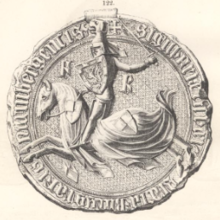Friedrich V (Nuremberg)
Friedrich V of Nuremberg (around 1333 - January 21, 1398 ) was burgrave of Nuremberg from the House of Hohenzollern from 1357 .
Life
Friedrich was the son of Burgrave Johann II of Nuremberg and Elisabeth Countess of Henneberg . Since his father's death in 1357 he had the title of burgrave and was responsible for securing the strategically important imperial castle of Nuremberg. The new burgrave, like his father before him, had to tolerate a secondary government by his younger brother Albrecht until 1361. Frederick V is said to have exceptional business acumen and a good knowledge of Latin, which enabled him to draft documents himself. In this context it is not surprising that he was also active in imperial politics beyond the limits of his possessions. He renewed the Reich loyalty of the House of Hohenzollern , it led him to the side of Emperor Charles IV. In the service of the Emperor, he took over the office of Reich Governor at the head of a Land Peace League in Franconia , after which he worked as Reich Governor in Alsace and later in Upper Swabia . His commitment to the imperial cause led Charles IV to elevate him to the rank of imperial prince with the privilege of 1363 as the first burgrave . It was confirmed to him in the form of a gold bull from the emperor that the House of Hohenzollern was a noble member of the empire ( nobile membrum sacri imperii ) and had belonged to the imperial prince class and enjoyed the privileges of the electors from time immemorial . These rights included, among other things, the privilege de non evocando , unlimited judicial power, the intervention of the emperor only in nationalistic denial of justice allow. Through purchases, Friedrich V succeeded in expanding the Hohenzollern territory. For example, in 1373 he acquired the city of Hof from the governors of Weida . Friedrich V abdicated in 1397 and died in 1398 on the Plassenburg , where he had retired.
Succession planning
Friedrich V wanted to avoid a division of the Hohenzollern area and put his sons Johann III. and Friedrich VI. close to doing without it. The principle of primogeniture had not yet established itself among the Hohenzollerns. In the Dispositio Fridericiana of 1385 it was stipulated that the brothers should rule together for the first ten years. Certain locks, regalia, and mines should be indivisible. The prince urged his sons to rule together afterwards. In the event that they did not want this, the Dispositio Fridericiana provided for the following division, which the brothers also adhered to: They were to look after the Nuremberg Castle and the regional court together. The land of the Hohenzollern was divided into the two main areas Bayreuth and Ansbach . Since Johann died in 1420 without an heir, his territory also fell to Friedrich after his death.
progeny
Friedrich, a brother-in-law of the Bishop of Bamberg ( Ludwig von Meißen , who secured the inheritance rights of the Burgrave in 1367), had been married to the Wettin princess Elisabeth von Meißen (1329-1375), daughter of Friedrich II. And granddaughter of Emperor Ludwig IV. , Since 1350 . Her descendants were:
- Beatrix (1355–1414), wife of Duke Albrecht III. from Austria
- Elisabeth (1358–1411), wife of King Ruprecht
- Agnes , (* 1366; † May 22, 1432), Poor Clare Monastery in Hof (1376–1386), married Baron Friedrich von Daber († July 15, 1410) in Constance in 1386, Frauenkloster in Hof (1406–1432), 1411– 1432 abbess
- Margarete (1367–1406), wife of Landgrave Hermann II of Hesse
- Johann III. , Burgrave (1369–1420)
- Friedrich VI. (1371–1440), burgrave, as Friedrich I first Elector of Brandenburg from the House of Hohenzollern
- Anna (1375-1392)
- Katharina (1375–1409), abbess of the Poor Clare Monastery in Hof
See also
literature
- Wolfgang Neugebauer : The Hohenzollern. Beginnings, state and monarchical autocracy until 1740 (Volume 1), Stuttgart, Berlin, Cologne 1996. ISBN 3-17012096-4
- Max Spindler , A. Kraus: History of Franconia up to the end of the 18th century . Munich 1997, ISBN 3-406-39451-5 .
- Theodor Hirsch : Friedrich V, burgrave of Nuremberg . In: Allgemeine Deutsche Biographie (ADB). Volume 7, Duncker & Humblot, Leipzig 1877, pp. 373-375.
- Günther Schuhmann: Friedrich V, burgrave of Nuremberg. In: New German Biography (NDB). Volume 5, Duncker & Humblot, Berlin 1961, ISBN 3-428-00186-9 , p. 523 ( digitized version ).
Individual evidence
- ^ Max Döllner : History of the development of the city of Neustadt an der Aisch until 1933. Ph. CW Schmidt, Neustadt an der Aisch 1950; Reprinted ibid 1978, p. 30.
| predecessor | Office | successor |
|---|---|---|
| Johann II. |
Burgrave of Nuremberg 1357-1397 |
Johann III. Friedrich VI. |
| personal data | |
|---|---|
| SURNAME | Friedrich V. |
| ALTERNATIVE NAMES | Friedrich I. (as imperial prince) |
| BRIEF DESCRIPTION | Burgrave of Nuremberg and (since 1363) Imperial Prince |
| DATE OF BIRTH | around 1333 |
| DATE OF DEATH | January 21, 1398 |
